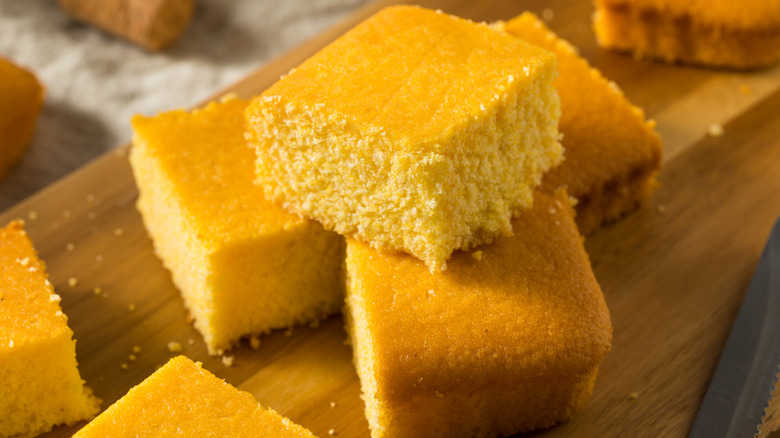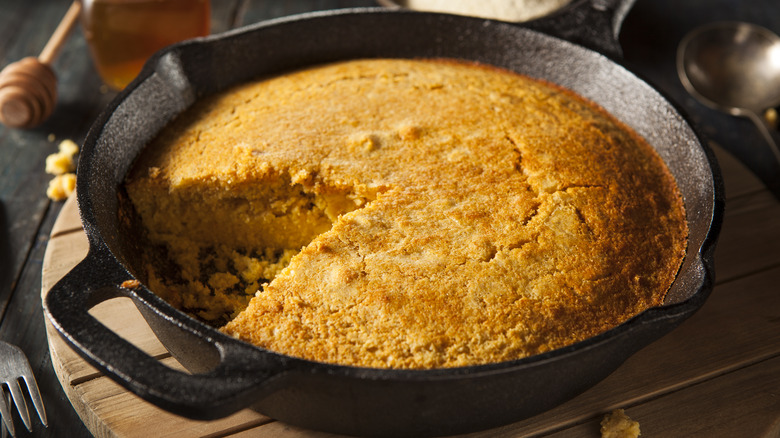The Difference In Cornbread Depending On Where You Are In The US
When you think of cornbread, you may associate it with American Southern food. That notion isn't incorrect; cornbread is a classic staple in the regional cuisine. But depending on where you are in the United States, a plate of cornbread may vary.
Various foods are considered cornbread, such as Johnnycakes, hushpuppies, hoecakes, and crackling bread. But there are two main versions of this beloved dish — head north, and you'll find Northern-style cornbread and travel south to nosh on Southern-style cornbread. While both styles generally use the same ingredients — cornmeal, flour, eggs, and baking powder — the variance lies in the flavor and texture.
Northern-style cornbread tends to be sweeter, moister, and cake-like compared to its Southern counterpart. Of course, there have been different versions of cornbread since its original conception by Native Americans. But if one version were to be considered the authentic one, Southern-style cornbread would most likely be credited, given its history.
The difference in cornbread lies in these key ingredients
If you prefer to stick to authenticity regarding cornbread, there are ways to do so. First, use a cast-iron skillet for Southern-style cornbread and a baking pan for Northern-style cornbread. To make the traditional Southern style, buttermilk — not just any milk — is key. Also, Southern-style cornbread should contain very little sugar and flour, and if you can, get your hands on stone-ground cornmeal. If you favor moist, sweet Northern-style cornbread, use flour and sugar liberally in your mix.
Whether you enjoy Northern or Southern-style cornbread, you can always fine-tune recipes to your liking. Experiment with sweeteners by adding molasses or honey. Sprinkle spices and herbs, such as thyme, rosemary, and parsley, into your batter for savory cornbread. Or toss in cheese like cheddar, pepper jack, or mozzarella for gooey goodness. Jalapeños and bacon are popular additions to cornbread for a spicy and smoky kick.
How we got two styles of cornbreads
The cornbread many enjoy today has very humble beginnings. Cornbread can be traced back to Mesoamerican societies. Corn, also known as maize, was an essential crop in Mesoamerican civilizations, and cornmeal was used to make tortillas and cornbread. This early version of cornbread was simply cornmeal and water. As enslaved people, settlers, and Native Americans intermingled, so did recipes as dishes were adopted and tweaked among different groups over time. This birthed various forms of cornbread, including Johnnycakes and hushpuppies.
So, how did we get to the two distinct cornbreads in the North and South? Prior to the 20th century, stone-ground white cornmeal was prevalent. White corn is naturally sweet; stone mills help preserve the corn meals' flavors and textures as the method is less processed. As food historian Michael Twitty tells The Charlotte Observer, sugar is traditionally absent in Southern-style cornbread because it was a "valuable commodity" and contained sweet white cornmeal.
When industrialized steel mills were introduced in the 20th century, steel-milled yellow cornmeal was favored, especially in the North. This resulted in a finer, less sweet cornmeal. Because yellow cornmeal was fine-grained and less sweet, sugar and flour were added to cornbread to boost its structure and sweetness. Over time, this led to vastly different cornbread recipes: Cornbread made with white cornmeal in the South and cornbread containing yellow cornmeal, sugar, and flour in the North. Whatever cornbread you prefer, both versions are rooted in rich history.


